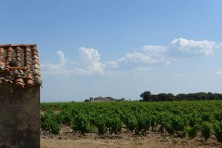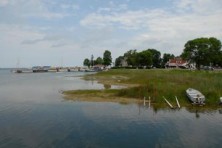Door County Beaches – Shifting Gears
- Share
- Tweet
- Pin
- Share

When 68 swimmers suffered gastrointestinal illness after swimming at Nicolet Beach, speculation abounded about the reason the Door County beaches so many thought were pristine were suddenly a health risk.
Fingers were pointed at Milwaukee sewer discharges, Chicago air pollution, and Fox Valley Paper Mills. But after four years of collecting and testing nearly 6,000 water samples taken at 34 Door County beaches, the verdict is clear. Beach contamination in Door County is a local problem requiring local solutions.
“Beach contamination is originating from onshore sources,” states the Door County Beach Contamination Source Identification Final Report, released by the Door County Soil and Water Conservation Department (SWCD) in March and authored by department conservationist Amanda Brown.
Those onshore sources include human and animal fecal matter, bird droppings, agricultural runoff and lawn chemicals, which are funneled to our beaches with storm water runoff when it rains.
“Storm water discharge during and after rain events is one of the clear sources of E. coli contamination in beach water throughout the county,” the report concludes.
Though rainfall is not the driver as a whole, it is at particular beaches, especially those with storm water outflows. Decades ago, before storm water runoff was part of the municipal lexicon, municipalities engineered roads and infrastructure so that storm water would be collected and funneled to the lake where the town or village owned shorefront, usually at a beach. The runoff transports pathogens from roads, parking lots and lawns to the very places we swim.
As a result, six beaches – Anclam, Ephraim, Otumba, Sunset, Fish Creek, and Lakeside Beach in Jacksonport – are under a wet weather advisory status. These beaches have shown consistent elevations of E. coli counts during and after rains.
Beach advisory and closure standards are set by the Wisconsin Department of Natural Resources and are based on a probability that people may become ill from swimming. An advisory is posted when the E. coli level indicates a probability that eight of 1,000 people will become ill from swimming, while a beach is closed when that probability rises to 14 of 1,000.
The Door County Public Health Department began the monitoring of E. coli in 2002 after the Nicolet Beach incident, and SWCD began a partnership with the University of Wisconsin-Oshkosh microbiology department in 2003 to continue the effort. Oshkosh microbiology students, overseen by Greg Kleinheinz, Assistant Professor of Microbiology, spent the last four summers in Door County monitoring beaches and testing samples, accumulating the data that formed the basis of the final report.
The monitoring program has earned the county a strong reputation for its beach management practices.
“Door County is taking the most pro-active approach in the state, if not the country,” Kleinheinz said.
The final report only confirms what Brown and others in her department have suspected for some time. Now, the beach program is changing gears after four years spent working to pinpoint the source of the problem through data collection and analysis.
“Generally, the beaches are improving,” Brown said. “Door County is doing very well compared to other beaches throughout the state. Now the focus is on what we can do about it and how much it will cost?”
The SWCD has developed a beach contamination reduction project made possible by a Wisconsin Coastal Management Grant, and the department is now working with eight municipalities to implement practices to create healthier beaches.
The department has identified a number of broad actions to be taken to reduce negative impacts on all Door County beaches. Following are the primary recommendations:
• Reduce storm water runoff at beaches. This could involve installing filtration systems to treat water before entering the lake, as Sister Bay has done, or creating natural filters with native vegetation. It may also mean extending storm water outflows further into the lake to keep pathogens away from the beach.
• Inform the public and municipalities about cleaning debris and sediment from storm inlets and sweep the street regularly.
• Remove Cladophora, an odorous green algae, from the beach regularly.
• Increase educational efforts. Use signage to warn people not to feed birds, to keep pets off the beach and to pick up garbage at the beach.
The entire beach contamination report is available at the SWCD Web site at http://map.co.door.wi.us/swcd/.


